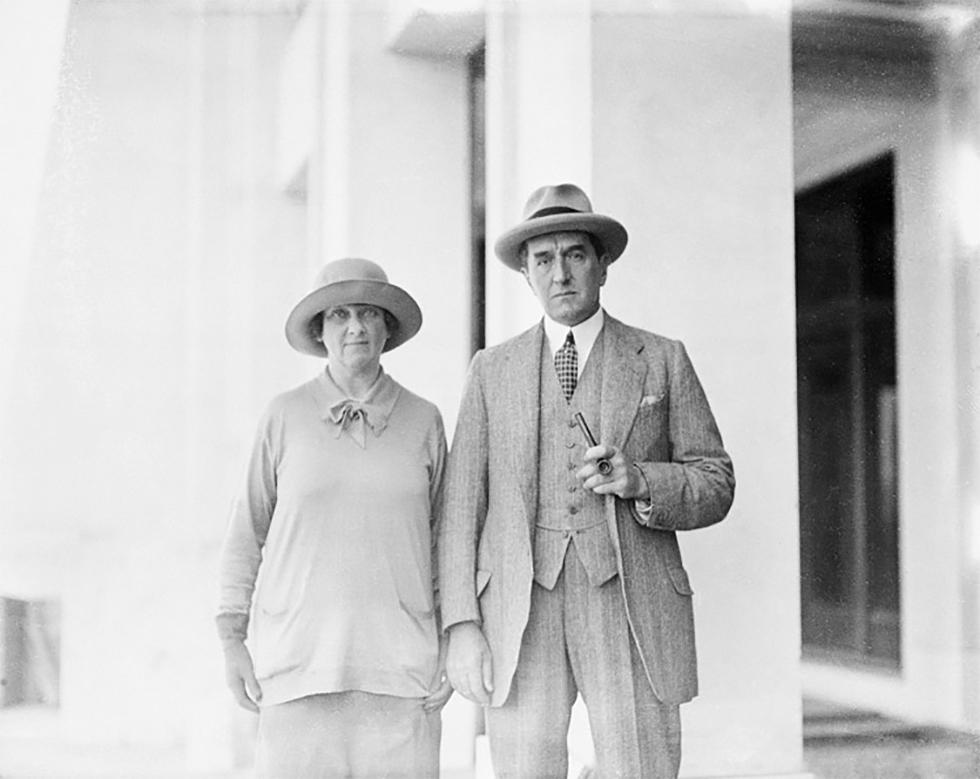


About this record
This black-and-white photograph shows Australian Prime Minister Stanley Melbourne Bruce and his wife Ethel at Old Parliament House, which at the time was still under construction. The couple are shown standing side-by-side with the front entrance columns of Parliament House visible behind them. Both are formally dressed in the fashions of the time and stare unsmilingly at the camera. Bruce is holding a pipe. The photograph was taken by official government photographer William James 'Jack' Mildenhall.
Educational value
- This photograph shows the eighth prime minister of Australia, Stanley Melbourne Bruce (1883-1967), Australia's second-youngest prime minister and the first to have had no involvement in Federation or the early federal parliaments. In 1926 he was in his fourth year in office and had only been in federal parliament since May 1918. His rise had been meteoric. In 1921 he was appointed treasurer, and in early 1923 he became prime minister at only 39 years of age.
- In 1926 Bruce was deemed the right prime minister for an optimistic and prosperous Australia during the ‘Roaring Twenties’. He was relatively young, stylish wealthy and a decorated war hero. However, his popularity and Australia's prosperity were not to last. It was a time of bitter industrial conflict and Bruce was seen as an enemy of workers. By 1929 Australia was in the grip of the Great Depression. In the October 1929 election his government was swept from office and Bruce became the first serving prime minister to lose his own seat.
- The establishment of Canberra was a Bruce government priority and both Ethel and Stanley Bruce were keen participants in the process. Provisional Parliament House, seen here, was opened in 1927. The Lodge, the Canberra home of prime ministers, was completed in 1927 and Ethel Bruce had a major role in its design and furnishing. Stanley Bruce's relationship with Canberra remained strong throughout his life and at his request his ashes were scattered there.
- Although Bruce lived much of his life in England, his focus was Australia, a nation whose future he believed would be shaped as part of the British Empire. At the time of this photograph he was working to establish Australia as a strong partner in imperial economic development within the Empire and to ensure that Australia was consulted in all matters of British foreign policy. After giving up politics in 1933 he became Australia's High Commissioner in London, a post he held until 1945.
- Bruce gained the prime ministership as the first beneficiary of a political alliance that still continues in federal politics – the coalition of a broad-based conservative party and a sectional rural party. In the December 1922 election the Nationalist Party led by William Morris Hughes won insufficient seats to form government and needed to form a coalition with the Country Party. Hughes was not acceptable to the Country Party and he resigned in favour of Bruce.
- This photograph was taken by William James 'Jack' Mildenhall (1891–1962) the Information Officer for the Federal Capital Commission in 1926. Mildenhall became the official photographer for Canberra during the 1920s and continued in the role until 1935. His photographs document the development of Canberra and life in the nation's capital, and comprise more than 7700 images on glass negatives.
Acknowledgments
Learning resource text © Education Services Australia Limited and the National Archives of Australia 2010.
Related themes
Need help with your research?
Learn how to interpret primary sources, use our collection and more.


